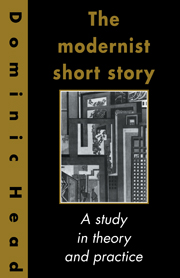Book contents
- Frontmatter
- Contents
- Preface
- Acknowledgements
- 1 The short story: theories and definitions
- 2 James Joyce: the non-epiphany principle
- 3 Virginia Woolf: experiments in genre
- 4 Katherine Mansfield: the impersonal short story
- 5 Wyndham Lewis: the Vorticist short story
- 6 Malcolm Lowry: expanding circles
- 7 Conclusion: contemporary issues
- Notes
- Bibliography
- Index
1 - The short story: theories and definitions
Published online by Cambridge University Press: 06 July 2010
- Frontmatter
- Contents
- Preface
- Acknowledgements
- 1 The short story: theories and definitions
- 2 James Joyce: the non-epiphany principle
- 3 Virginia Woolf: experiments in genre
- 4 Katherine Mansfield: the impersonal short story
- 5 Wyndham Lewis: the Vorticist short story
- 6 Malcolm Lowry: expanding circles
- 7 Conclusion: contemporary issues
- Notes
- Bibliography
- Index
Summary
The rise of the modern short story in the 1880s and 1890s indicates that the written story enjoyed a period of significant development – arguably the birth of a new kind of short story – which was concurrent with the emergence of literary modernism. This concurrence is more than circumstantial: there are various connections between the formal properties and capacities of the short story and the new ways of representing the social world displayed in modernist fiction. This survey seeks to investigate the nature of the relationship between modernism and the short story, an area, strangely neglected by critics, which has important resonances both in terms of literary history, and in defining the role of fiction-making in the twentieth century: the short story encapsulates the essence of literary modernism, and has an enduring ability to capture the episodic nature of twentieth-century experience.
I am proposing a connection between the generic capacities of the short story and the way in which writers have depicted their social world, a connection which stems from a special kind of literary experience relevant to readers, as well as to writers, of short stories. L. P. Hartley, discussing the status of the short story in the 1960s, noted how readers were apt to ‘devour them singly on a news[s]heet’, but would be disinclined to read them in collections. The reason for this was (and is) the ‘unusual concentration’ the genre demands, a concentration which permits no respite in a series of short stories because ‘“starting and stopping” exhausts the reader's attention just as starting and stopping uses up the petrol in a car’.
- Type
- Chapter
- Information
- The Modernist Short StoryA Study in Theory and Practice, pp. 1 - 36Publisher: Cambridge University PressPrint publication year: 1992



